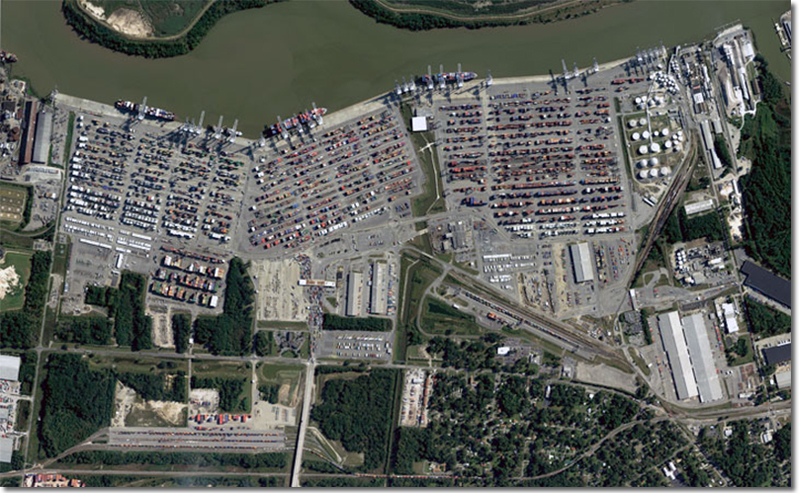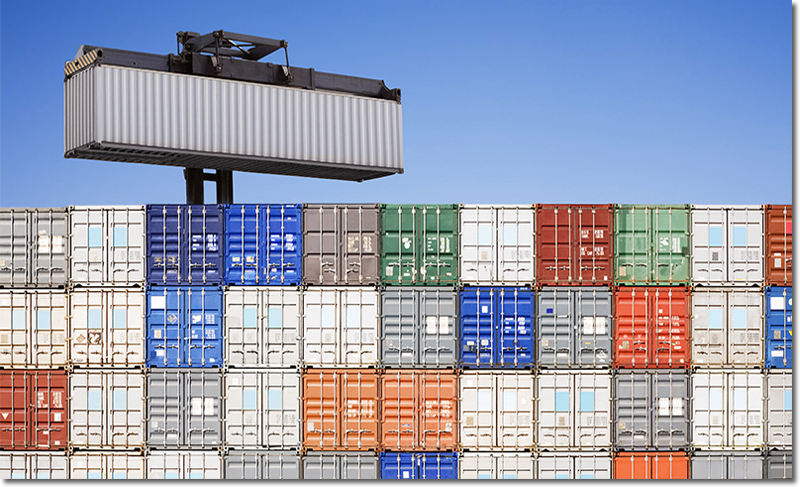Rail Still Dominates the Logistics Landscape

From the incorporation of the Baltimore and Ohio railroad to the modern freight-moving workhorses of CSX and Norfolk Southern and dozens of regional “short-line” railroads, trains have played a central role in bringing goods to market. By Mary Carr Mayle
January 29, 2015
One of the first tenants of the logistics business is this:Time is money.
Nowhere is that more apparent than at our nation’s container ports, where speed and efficiency - in transit, in loading and unloading - factor into the price we pay for everything from groceries to electronics.
At Georgia Ports Authority, Curtis Foltz and his board are keenly aware of the need for speed, which is why they are turning more of their attention to one of the nation’s oldest transportation providers.
From the incorporation of the Baltimore and Ohio railroad in 1827 to the modern freight-moving workhorses of CSX and Norfolk Southern and dozens ofregional “short-line” railroads, trains have played a central role in bringing goods to market all around the country.
It’s a role that, rather than diminish with time, has only been enhanced.
“Over time, over-the-road freight movement via truck will continue to become more expensive and less environmentally friendly,” Foltz said, adding that his team is constantly working with CSX and Norfolk Southern to find ways to move a higher percentage of freight by rail.
In the calendar year just completed, Georgia Ports moved 340,000 containers by rail, an increase of 5 percent over 2013, he said.

“Rail expansion has been a huge part of our capital improvement budget over the last decade or more, and we expect that to continue as we work with both CSX and Norfolk Southern to improve the efficiency of our rail connections and speed and further develop our inland connections,” he said.
“We’ve been very collaborative with both major railroads as we work to provide our customers with the tools they need to move their freight as effectively as possible.”
Craig Camuso, Regional Vice President - State Government Affairs at CSX Transportation, agreed.
“We have a great partnership with Georgia Ports,” said Camuso, regional vice president at CSX Transportation. “Their growth has helped spur our growth.”
CSX moves 150,000 20-foot containers - or TEUs - through the Savannah port every year.
“We’re fortunate in that the Georgia Ports Authority has long recognized the value and advantages of rail freight, and the entire rail industry has benefitted,” he said. “At a time when on-time and next-day service is so important, the partnership we have with the port and the state is critical.
“When the port succeeds, we do, too.”
Camuso, whose company recently announced it would raise freight rates in the wake of record-setting revenue in 2014, said rail remains the most fuel-efficient way to move cargo.
“According to our latest calculations, we can move a ton of freight nearly 500 miles on a single gallon of gas,” he said. “But fuel savings is only one of rail’s public benefits.
“Freight that moves by rail is freight that is off our roads, reducing the wear and tear and adding an element of safety,” he said.
Rail is also a cleaner way to move freight, reducing the carbon footprint, he said.
On-Dock Access
One of the attributes that makes Georgia Ports’ Garden City Terminal unique is its on-dock facilities for both of the Class I Railroads that serve the Southeast – CSX and Norfolk Southern.
One of the attributes that makes Georgia Ports’ Garden City Terminal unique is its on-dock facilities for both of the Class I Railroads that serve the Southeast – CSX and Norfolk Southern.
The Mason Intermodal Container Transfer Facility, which serves Norfolk Southern, was opened in 2001, while the Chatham Yard ICTF, serving CSX, came online in late 2008.
When Georgia Ports dedicated the Mason ICTF in July 2001, the Port of Savannah ranked seventh in the country in terms of containers handled.
Today, it’s solidly established in the No. 4 position and creeping up on the Port of New York/New Jersey, which sits at No. 3.
Most port watchers agree the port’s on-terminal intermodal facilities – which allow for seamless container movement from vessels to dedicated unit trains for expedited delivery to markets throughout the Southeast, Gulf Coast and Midwest – have played a major role in that growth.
With a dedicated transfer facility, time is saved in two ways. First, containers destined for rail service are brought to a specific area. Before the change, containers being unloaded from ships weren’t systematically grouped and had to be plucked out individually for transfer to railcars.
Second, when trains are formed on the transfer facility, containers are grouped on cars according to their final destinations. For example, one section might have cars going to Chicago, while another is headed to Charlotte. This allows for rapid transfer when the trains reach the massive switching yards outside Atlanta.
“Before we had the (transfer facility) at Georgia Ports, our operation was on dock, but not in the sense we have today,” said Jeff Heller, vice president for intermodal and automotive marketing at Norfolk Southern. “The tracks literally ran out onto the berth, so rail operations conflicted with vessel operations. It wasn’t very efficient.
“They also had a third-party railroad that did the switching, which also wasn’t efficient.
“We worked very closely with the GPA, from their engineers to their funding people, to develop a facility that would be efficient for both of us.
“The intermodal facility across from the terminal gave us the advantage of longer tracks, bigger trains and the ability to run mainline trains in and out of the facility, saving on transit times both in and out of the facility.”
In 2001, when the facility opened, Norfolk Southern was running three trains a week each way, Heller said.
“Today, we’re running two trains a day in each direction, and these are not your ordinary trains,” he said.
The trains rolling in and out of Georgia Ports can be from 8,000 feet to 10,000 feet long, he said, adding that each train carries the equivalent loads of 280 to 300 trucks.
“That’s a lot of trucks off the road, not to mention the pressure it takes off the truck gates at the port,” he said.
“As East Coast port activity continues to grow, it’s driving more freight through ports like Savannah that have a great facility and structure as well as a first-class on-dock rail operation.”
Growing the Competitive Advantage
Not content to rest on the efficiencies of its on-terminal rail facilities, Georgia Ports last year introduced an initiative aimed at saving customers money by helping them develop more efficient cargo handling beyond the port. The initiative, designed around the port’s rail capacity, is called Rapid Routes.
Not content to rest on the efficiencies of its on-terminal rail facilities, Georgia Ports last year introduced an initiative aimed at saving customers money by helping them develop more efficient cargo handling beyond the port. The initiative, designed around the port’s rail capacity, is called Rapid Routes.
“Rail is an important facet of extending customers’ reach into the hinterlands,” Foltz said. “So we began our Rapid Routes program with an outreach effort informing customers of our competitive advantages in rail.”
Among those advantages is that, through the Norfolk Southern and CSX intermodal facilities, the port can offer overnight service to a five-state area - Alabama, Georgia, Florida, North Carolina and South Carolina - with two-day service to Birmingham and Huntsville, Ala.; Miami, Orlando and Tampa, Fla.; and Memphis and Nashville, Tenn.
Savannah also features the fastest rail connections of any East Coast port to Louisiana and Texas.
The port also expanded the Mason facility in 2012, cutting round-trip Norfolk Southern train movements to Atlanta by six hours.
Sandy Lake, associate director at the Georgia Center of Innovations for Logistics, said the efficiency of the state’s rail freight is critical to the further expansion of the state’s ports, intermodal expansion and reduced highway volumes, all of which are considered vital to maintain Georgia’s competitive position in the marketplace.
In a recent state logistics study, opportunities were seen to improve intermodal access and divert truck traffic from congested highways by way of rail.
The study also recognized the state’s short line railroad network as being essential to provide rail access to the numerous communities not served by the large railroads and to attract new industries or facilitate industry expansion in these communities.
Shippers served by Class I railroads noted the importance of rail service in terms of transportation cost savings, especially regarding the movement of bulk commodities and shipments over long distances, she said.
According to the center for logistics, Georgia’s nearly 5,000 miles of railroad track, together with its world-class intermodal facilities strategically located around the state, enable importers and exporters to quickly and efficiently move products from ocean carrier, to rail to truck.
“Georgia’s intermodal facilities have some of the fastest transition times in the United States,” she said, adding that Georgia has the seventh-most total rail miles in the country and ranks fifth in most rail tons terminating in a state.
Intermodal Service via Port Of Savannah
Through Class I Railroads Norfolk Southern and CSX Transportation, the Port of Savannah provides the following intermodal services:
Through Class I Railroads Norfolk Southern and CSX Transportation, the Port of Savannah provides the following intermodal services:
Exports
- Overnight service from Atlanta, Jacksonville and Charlotte
- Two-day service from Winter Haven, Fla., and Birmingham
- Three-day service from Chicago, Cincinnati, Nashville, Memphis Imports
- Overnight service to Atlanta, Charlotte, Jacksonville, Winter Haven and Birmingham
- Two-day service to Memphis and Nashville
- Three-day service to Chicago, Cincinnati and Dallas




No comments:
Post a Comment